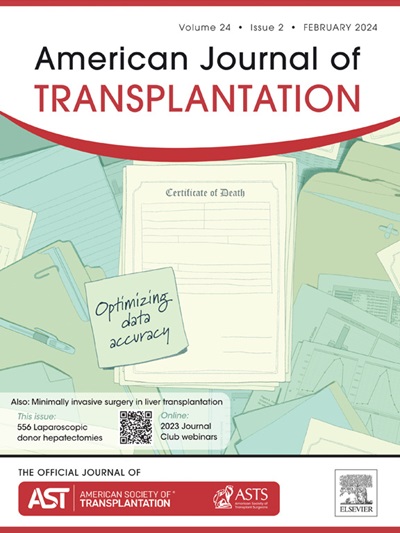基于血液的 PT-LIFE(小儿肝移植-肝纤维化评估)生物标记物面板,用于肝移植后小儿肝纤维化的无创评估:前瞻性推导和验证研究。
IF 8.9
2区 医学
Q1 SURGERY
引用次数: 0
摘要
随着术后时间的延长,移植物活检中发现的同种异体纤维化越来越多,有可能成为决定小儿受者长期移植物功能和移植物存活率的关键因素。目前,能够识别小儿肝移植受者异体移植物纤维化的非侵入性诊断工具还很少。这项研究涉及 507 名小儿肝移植患者,并开发了一种新型的血液诊断测定 PT-LIFE,利用血液样本、临床数据和活检结果无创鉴别异体移植物纤维化。PT-LIFE检测方法由23个变量组成,并在两个独立队列中进行了验证。它整合了三个生物标记物(LECT2、YKL-40、FBLN3),AUROC为0.91。在汇总分析中,PT-LIFE 评分低于 0.12 时,可识别 LAFSc 0-2,灵敏度为 91.9%;评分高于 0.29 时,可识别 LAFSc 3-6,特异性为 88.4%。PT-LIFE测定是检测小儿肝移植受者异体移植物纤维化的一种很有前景的无创诊断工具。该研究已在 ClinicalTrials.gov 注册,标识符为 NCT05308628。本文章由计算机程序翻译,如有差异,请以英文原文为准。
A blood-based PT-LIFE (Pediatric Liver Transplantation-LIver Fibrosis Evaluation) biomarker panel for non-invasive evaluation of pediatric liver fibrosis after liver transplantation: a prospective derivation and validation study.
Allograft fibrosis is increasingly detected in graft biopsies as the postoperative period extends, potentially emerging as a pivotal determinant of long-term graft function and graft survival among pediatric recipients. Currently, there is a paucity of non-invasive diagnostic tools capable of identifying allograft fibrosis in pediatric recipients of liver transplants. This study involved 507 pediatric liver transplant patients and developed a novel blood-based diagnostic assay, PT-LIFE, to noninvasively distinguish allograft fibrosis using blood samples, clinical data, and biopsy outcomes. The PT-LIFE assay was derived from a matrix of 23 variables and validated in two independent cohorts. It integrates three biomarkers (LECT2, YKL-40, FBLN3) with an AUROC of 0.91. In the pooled analysis, a PT-LIFE score lower than 0.12 identified LAFSc 0-2 with a sensitivity of 91.9%, whereas scores above 0.29 indicated LAFSc 3-6, with a specificity of 88.4%. The PT-LIFE assay presents as a promising non-invasive diagnostic tool for the detection of allograft fibrosis in pediatric liver transplant recipients. The study is registered with ClinicalTrials.gov, identifier NCT05308628.
求助全文
通过发布文献求助,成功后即可免费获取论文全文。
去求助
来源期刊
CiteScore
18.70
自引率
4.50%
发文量
346
审稿时长
26 days
期刊介绍:
The American Journal of Transplantation is a leading journal in the field of transplantation. It serves as a forum for debate and reassessment, an agent of change, and a major platform for promoting understanding, improving results, and advancing science. Published monthly, it provides an essential resource for researchers and clinicians worldwide.
The journal publishes original articles, case reports, invited reviews, letters to the editor, critical reviews, news features, consensus documents, and guidelines over 12 issues a year. It covers all major subject areas in transplantation, including thoracic (heart, lung), abdominal (kidney, liver, pancreas, islets), tissue and stem cell transplantation, organ and tissue donation and preservation, tissue injury, repair, inflammation, and aging, histocompatibility, drugs and pharmacology, graft survival, and prevention of graft dysfunction and failure. It also explores ethical and social issues in the field.

 求助内容:
求助内容: 应助结果提醒方式:
应助结果提醒方式:


